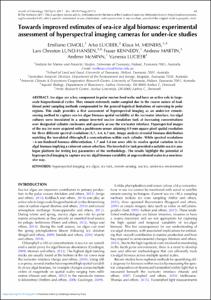| dc.contributor.author | Cimoli, Emiliano | |
| dc.contributor.author | Lucieer, Arko | |
| dc.contributor.author | Meiners, Klaus M. | |
| dc.contributor.author | Lund-Hansen, Lars Chresten | |
| dc.contributor.author | Kennedy, Fraser | |
| dc.contributor.author | Martin, Andrew | |
| dc.contributor.author | McMinn, Andrew | |
| dc.contributor.author | Lucieer, Vanessa | |
| dc.coverage.spatial | Polar Region | en_US |
| dc.date.accessioned | 2023-05-14T18:36:46Z | |
| dc.date.available | 2023-05-14T18:36:46Z | |
| dc.date.issued | 2017 | |
| dc.identifier.citation | Cimoli, E., Lucieer, A., Meiners, K. M., Lund-Hansen, L. C., Kennedy, F., Martin, A., McMinn, A. and Lucieer, V. (2017) Towards improved estimates of sea-ice algal biomass: Experimental assessment of hyperspectral imaging cameras for under-ice studies. Annals of Glaciology, 58, pp.68–77. DOI: https://doi.org/10.1017/aog.2017.6 | en_US |
| dc.identifier.uri | https://repository.oceanbestpractices.org/handle/11329/2210 | |
| dc.description.abstract | Ice algae are a key component in polar marine food webs and have an active role in large-scale biogeochemical cycles. They remain extremely under-sampled due to the coarse nature of traditional point sampling methods compounded by the general logistical limitations of surveying in polar regions. This study provides a first assessment of hyperspectral imaging as an under-ice remote-sensing method to capture sea-ice algae biomass spatial variability at the ice/water interface. Ice-algal cultures were inoculated in a unique inverted sea-ice simulation tank at increasing concentrations over designated cylinder enclosures and sparsely across the ice/water interface. Hyperspectral images of the sea ice were acquired with a pushbroom sensor attaining 0.9 mm square pixel spatial resolution for three different spectral resolutions (1.7, 3.4, 6.7 nm). Image analysis revealed biomass distribution matching the inoculated chlorophyll a concentrations within each cylinder. While spectral resolutions >6 nm hindered biomass differentiation, 1.7 and 3.4 nm were able to resolve spatial variation in ice algal biomass implying a coherent sensor selection. The inverted ice tank provided a suitable sea-ice analogue platform for testing key parameters of the methodology. The results highlight the potential of hyperspectral imaging to capture sea-ice algal biomass variability at unprecedented scales in a non-invasive way. | en_US |
| dc.language.iso | en | en_US |
| dc.rights | Attribution 4.0 International | * |
| dc.rights.uri | http://creativecommons.org/licenses/by/4.0/ | * |
| dc.subject.other | Hyperspectral imaging | en_US |
| dc.subject.other | Sea-ice algal biomass | en_US |
| dc.subject.other | Sea Ice | en_US |
| dc.subject.other | Ice algae | en_US |
| dc.subject.other | Under ice remote sensing | en_US |
| dc.title | Towards improved estimates of sea-ice algal biomass: experimental assessment of hyperspectral imaging cameras for under-ice studies. | en_US |
| dc.type | Journal Contribution | en_US |
| dc.description.refereed | Refereed | en_US |
| dc.format.pagerange | pp.68-77 | en_US |
| dc.identifier.doi | http://dx.doi.org/10.1017/aog.2017.6 | |
| dc.bibliographicCitation.title | Annals Of Glaciology | en_US |
| dc.bibliographicCitation.volume | 58 | en_US |
| dc.description.sdg | 14.a | en_US |
| dc.description.maturitylevel | Pilot or Demonstrated | en_US |
| dc.description.sensors | Li-COR PAR sensor | en_US |
| dc.description.sensors | Pushbroom SPECIM AISA KESTREL 10 (AK10) hyperspectral line scanner | en_US |
| dc.description.sensors | TRiOS RAMSES radiance sensor | en_US |
| obps.contact.contactname | Cimoli, Emiliano | |
| obps.contact.contactemail | emiliano.cimoli@utas.edu.au | |
| obps.resourceurl.publisher | https://www.cambridge.org/core/journals/annals-of-glaciology/article/towards-improved-estimates-of-seaice-algal-biomass-experimental-assessment-of-hyperspectral-imaging-cameras-for-underice-studies/37007859A331C6527FD9825A10102949 | |
 Repository of community practices in Ocean Research, Applications and Data/Information Management
Repository of community practices in Ocean Research, Applications and Data/Information Management

